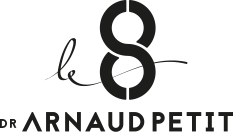The lateral body lift
Silhouette surgery
Some patients are complexed with a disproportion accentuated between the upper area (relatively thin) and the lower area of their body (large), which causes difficulties in getting dressed. Unfortunately, this disproportion tends to intensify during a weight loss, which often tightens the upper body but does not act on jodhpur thighs. Thus, patients develop a negative image of their silhouette that they liken to the shape of an « Orangina bottle », generating a lack of self-confidence.
The lateral body lift is a little-known procedure which is not wide-spread in France, which enables to reduce the lower body volume in order to harmonize it with the rest of the silhouette. It enables to bring an efficient answer to patients with very large jodhpur thighs, which cannot be treated optimally by a liposuction or by a classical lower body lift.
This technique has undergone very little evolution since 1960 and has been modernized by Dr. Jean-François Pascal, who has been one of the masters of Dr. Petit during his surgical training.

Procedure steps
- Dr. Petit will ask you a number of questions about your medical and surgical histories (especially bariatric surgery: by-pass, sleeve gastrectomy, gastric ring), your weight and your size as well as your tobacco consumption.
- He will listen to you in order to understand your motivations as well as your expectations relating to your silhouette.
- He will perform a thorough physical exam, in order to suggest the most appropriate surgical strategy relating to your anatomy and to your request.
- Several cases can be met. If you have a moderate cutaneous excess at the level of outer thighs with a good quality skin, a liposuction will be chosen to reduce the volume of your jodhpur thighs.
- However, if a cutaneous excess is identified at the level of the outer thighs, the liposuction will aggravate the problem. Then, three surgical techniques are discussed according to your skin slackening characteristics :
- If this one prevails in the lenghtwise of the thigh, a lower body lift will be suggested in order to correct it.
- If the cutaneous excess prevails in width, the chosen procedure will be an outer thigh lift.
- When the cutaneous excess is mixed (both in length and in width), a lateral body lift associating, in one single surgical process, a lower body lift with an outer thigh lift will be suggested.
- Dr. Petit will provide information on the scar positioning, treatment process and procedure limits, post-operative recoveries as well as main risks, so as to make an informed decision.
Procedure limits
The outer thigh lift does not act on the skin tightening of the inner thigh lift. The latter will imply an inner thigh lift.
Good candidates for a lateral body are those
- With circumferential cutaneous fat excess in the lower body area (at belt level), associated with major circumferential cutaneous fat excess in outer thighs, causing a disproportion between the upper area and the lower area of the body (also known as the gynoid syndrome).
- With aesthetic and functional unease
- Accepting the scarring price.
- And having understood the procedure limits.
Pre-operative instructions
General pre-operative instructions relating to aesthetic surgery
- Smoking cessation 1 month before and after the procedure.
- Discontinuation of medicines which increase bleeding 10 days before and after the procedure: aspirin, anti-inflammatory and anticoagulant medicines, vitamin E.
Specific pre-operative instructions relating to silhouette surgery
- Be at your ideal weight and stable for at least 6 months.
- Discontinuation of oral contraception 1 month before the intervention to reduce the risk of thromboembolism (phlebitis and pulmonary embolism).
- Purchase of a compression garment.
Procedure stages
Pre-operative markings are performed by Dr. Petit before the procedure.
The operation is performed under general anesthesia, with hospitalization from two to three nights at the Surgical Center on average.
It starts with a liposuction and an excision of the cutaneous fat excess in width at the level of the outer thighs (corresponding to the schematized vertical spindle). The following surgical process is a lower body lift, which aims to remove the circumferential cutaneous fat excess in the lower body (corresponding to the schematized horizontal spindle), and to tighten the skin of the buttocks and the belly.
Three scars are necessary:
- 1 lower circular scar hidden in the pants (corresponding to the lower body lift).
- 1 vertical scar at the level of the outer area of each thigh (corresponding to the outer thigh lift).
The skin closure is performed with subcutaneous dissolving sutures.
A dressing modeling the buttocks, the abdomen and the thighs is performed at the end of the procedure.
What to expect after surgery
The lateral body lift is a moderately painful procedure in the absence of an associated gesture on the abdominal wall muscles. Pains are soothed by analgesics.
Ecchymosis (bruises) are classical and last 2 à 3 weeks after the procedure.
An œdema (swelling) is constant and of varying lengths, diminishing within a few months.
Daily nursing care after your shower with a soft soap are necessary during 15 days.
Three preventive measures against phlebitis are established after the procedure: the affected leg elevated as well as the walk, the wearing of compression stockings and the daily injection of an anticoagulant (medicines which thin the blood) during 15 days.
The sitting position is not recommended during 10 days in order to limit the cutaneous pressure on the scar, especially at the intergluteal cleft area, a fragile region for the scarring. The sitting and lying positions have to be initially privileged.
It is recommended to wear a compression garment during 1 month to reduce the post-operative oedema.
The progressive resumption of daily activities is possible within the first post-operative days. It is a tiring procedure and rest is recommended for 3 weeks to 1 month.
The resumption of professional activities can be done within 3 weeks to 1 month after the procedure, and depends on the operative gesture performed and on the patient’s work.
The resumption of sports activities is authorized within 6 weeks after the procedure.
Procedure risks
The potential complications of a lateral body lift are weak, provided that it is performed by a surgeon specialized in this type of procedure.
Mains risks are the following
In the first hours following the surgery:
- a haematoma (blood pooling), a rare complication requiring a revisionary process in order to drain it.
In the post-operative month:
- Healing problems, resulting in one or several localized disunities (opening of the scar) requiring a directed healing.
- A seroma (collection of fluid), requiring a drainage in consultation.
- Transitory troubles of skin sensitivity.
- An infection, a cutaneous neurosis: rare complications.
- A phlebitis, a pulmonary embolism: exceptional complications with the preventive measures established previously.
In the long term:
- A scar expansion: the most frequent complication, which requires a revisionary procedure.
- A pathological scarring (hypertrophic scars or keloids).
Long-term outcome
The final result relating to a lateral body lift is reached between 3 to 6 months after the procedure, once the post-operative edema has disappeared.
The scar initially is inflammatory (red and swollen) throughout the first months, then it will fade progressively without disappearing. The final aspect of your scar is not predictable and will be known at the end of the cicatricial maturation (between 1 and 2 years after the procedure).
This result is stable and long-lasting except in cases of fluctuations in body weight or pregnancy.
The lateral body lift gives spectacular results by harmonizing the upper area and the lower area of the body. As a result, patients lose several pant sizes in one single procedure. It generates a huge aesthetic and functional benefit, which accounts for a high degree of satisfaction of the patients using this surgery.


